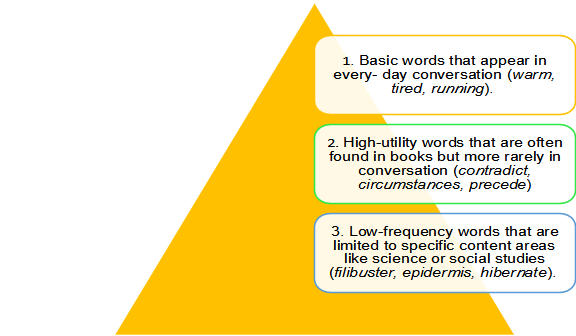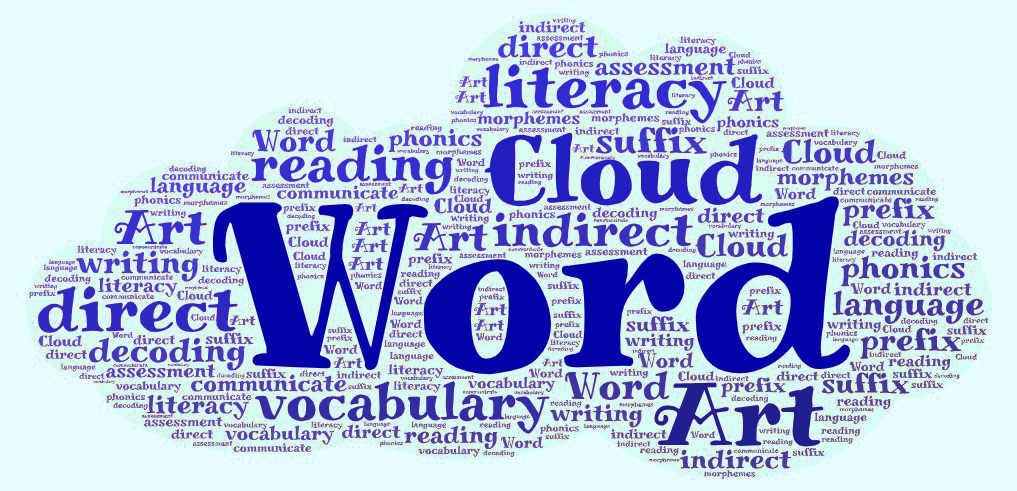Chapter 6. Vocabulary
Constance Beecher
“Words are, in my not-so-humble opinion, our most inexhaustible source of magic.” – Albus Dumbledore in Harry Potter and the Deathly Hollows

Keywords: oral and written language, indirect vocabulary, direct vocabulary, structured word analysis
Iowa Core Standards
Iowa Core Standards include vocabulary across reading, writing, speaking, and listening. The Iowa Core states: “The vocabulary standards focus on understanding words and phrases, their relationships, and their nuances and on acquiring new vocabulary, particularly general academic and domain-specific words and phrases.” (Iowa Core English Language Arts, 2022, p.8)
The K-5 standards define what students should know and be able to do. These are backwards mapped from the College and Career Readiness Anchor Standards. Therefore, if students meet the grade-level standards at each grade, they will be ready for college or career training. The Anchor Standards for vocabulary are as follows:
Vocabulary acquisition and use
- Determine or clarify the meaning of unknown and multiple-meaning words and phrases by using context clues, analyzing meaningful word parts, and consulting general and specialized reference materials, as appropriate.
- Demonstrate understanding of figurative language, word relationships, and nuances in word meanings.
- Acquire and use accurately a range of general academic and domain-specific words and phrases sufficient for reading, writing, speaking, and listening at the college and career-readiness level; demonstrate independence in gathering vocabulary knowledge when encountering an unknown term important to comprehension or expression.
Language standards K-5
Download the Iowa Core Literacy standards. In the table of contents, you will find Language Standards for grades K-5. As stated, “the language standards offer a focus for instruction each year to help ensure that students gain adequate mastery of a range of skills and applications.”( (Iowa Core English Language Arts, 2022, p.35) Vocabulary standards are found in both the Writing and the Language standards for K-5 (and 6-12).
For example, “d. Use precise language and domain-specific vocabulary to inform about or explain the topic.” (Writing.4.2) (DOK 3,4) is a writing standard.
And “4. Determine or clarify the meaning of unknown and multiple-meaning words and phrases based on grade 1 reading and content, choosing flexibly from an array of strategies. (Language.1.4) (DOK 2) is a language standard.
Watch this video of a teacher teaching vocabulary through a read-aloud: what strategies does Dr. Wright say she will use to teach the vocabulary words?
Did you see them all?
Why focus on vocabulary?
Extensive research on literacy development is clear – vocabulary knowledge is a major player in the game of reading (National Early Literacy Panel, 2008).
Vocabulary knowledge predicts kindergarten readiness, and third-grade reading. Children who know a lot of words easily learn new words, while children who come to school knowing fewer words may struggle to catch up (Dickinson & Porche, 2011). When children already know a word, it is easier for them to decode it using their phonological skills. Researchers Hart and Risley (1995) found that the number of words that children heard in the home before attending kindergarten predicted how many words they knew and how fast they could learn new words.
Vocabulary knowledge affects reading skills in several ways:
- supports comprehension of words that children are decoding;
- helps children recognize words more quickly while they are decoding;
- supports phonological awareness, and
- increases child’s understanding of content instruction.
Learning new words is a part of a child’s language development, and it is important for both oral language and written language. Children need to be able to understand (receptive language) and communicate to others (expressive language).
This is illustrated in the table below:
|
|
Receptive Language |
Expressive Language |
|
Oral Language |
Listening |
Speaking |
|
Written Language |
Reading (decoding + comprehension) |
Writing (handwriting, spelling, composition) |
These abilities do not develop at the same pace. Children usually understand words before they can use them correctly. This is especially true for children who are developing English or children at risk for developmental delay.
Researchers suggest there are three levels of vocabulary understanding. It is not as simple as knowing a word or not knowing a word. Children can either 1) have no knowledge of a word; 2) be acquainted with it (have been exposed to it); or 3) have an established knowledge of it, whereby they can give a definition.
In the chapter on Phonics, you learned about morphemes, which are the smallest units of meaning in words. The ability to identify prefixes and suffixes, and to understand how they change word meanings, also impacts vocabulary development. In English, our letters do not perfectly represent the sounds of words, but meaning across words is often represented by morphemes:
Sign
Nature
Bomb
Deport
Signal
Natural
Bombardment
Deportment
Early readers may learn simple morphemes like s for plural and ed for past-tense words. It is not until second or third grade that children begin to master the more complex ones. It is important to teach students about word parts so they can work out the meanings of unfamiliar words and grow their academic vocabulary.
It was previously thought that younger children should not be introduced to morphology, but current research suggests it benefits phonological awareness, spelling ability, and vocabulary (Bowers, 2020).
How to teach vocabulary
Vocabulary is one of the five essential components of literacy instruction.
Recall The 5 essential components:
- phonemic awareness,
- phonics,
- fluency,
- vocabulary,
- comprehension.
Vocabulary is the study of word meaning
- Students are not required to know how to spell or even read a word accurately to study vocabulary, as the focus is on word meanings.
- Vocabulary “sets the ceiling” on student comprehension.
- Vocabulary is taught in the context of stories or non-fiction texts and explicitly within word-study lessons.
- Children learn implicitly from purposeful conversations and read-alouds.
Indirect vocabulary learning
Children learn most words indirectly, through everyday interactions in discussions and exposure to books. This happens in three ways:
- They engage daily in oral language – primarily discussion with adults.
- They listen to adults reading to them.
- They read on their own and pick up meaning from the text.
Direct vocabulary learning
Although a lot of vocabulary is learned indirectly, some vocabulary should be taught directly. Direct instruction helps students learn difficult or unfamiliar words that are not part of their everyday experiences. This is done in interactive read-alouds and word-study lessons.
The direct instruction of vocabulary includes:
- Teaching the specific words that are important to the students’ content learning or understanding of a particular text (fiction or non-fiction).
- Teaching students general word-learning strategies that they can apply to a variety of words, such as analyzing parts of words (e.g., root words).
Choosing words to teach
In the book Bringing Words to Life: Robust Vocabulary Instruction, by Beck, McKeown and Kucan, (2013, 2nd ed) the authors suggest a three-tier framework for considering which words to teach:

Teachers should spend the majority of vocabulary-instruction time on tiers two and three. However, students who are learning English (English Language Learners or Emergent Bilinguals) may need instruction in tier-one words.
Text talk
Beck et al. (2013) propose a teaching sequence they call “text talk.” Researchers Manyak et al. (2014) adapted that sequence for their multifaceted vocabulary-instruction project and suggest the VP Model for introducing target-word meanings:
- Present the word in the context in which it appears in a text (whenever possible): “The attendants insisted…”
- Provide a kid-friendly definition: “Insist or, in the past tense insisted, means someone tells you strongly that you have to do something, like,
‘My mother insisted that I do my homework before watching TV.’ ” - Provide multiple examples of use: “I might say, ‘Our coach insisted we run the play until we got it right.’ Or, ‘I was hot, but my sister insisted I close the window.’ Or, ‘His mother insisted that he clean up his room before his friend came over.’ ”
- Prompt student use: “Think of all the things that your parents insist that you do. Who can share one? Make sure that you use the word insist, like, ‘My mom insists that I…’ ”
- Show and briefly discuss a visual image: “Look at this picture. Who can explain why I am showing you this picture for the word insist?”
- Conclude with a thought question and/or a quick interactive activity:
- Thought Question: “Do you think it is better for your reading when a teacher insists that you read challenging books or when you can choose any books you want? Try to use insist in your answer.”
- Interactive Activity: “OK, ready for a little quiz? I am going to say a sentence. If someone in the sentence insisted on something, say insist. If not, don’t say anything. My dad’s boss told him he had to work late, even though my dad didn’t want to. My teacher let us choose what we wanted to do for P.E. (Manyak et al., 2014, p.16).”
Researchers Manyak et al. (2014) suggest using a weekly formative assessment such as a cloze activity. Cloze informal assessments are created by either selecting a passage and deleting the target word, leaving a blank for the student to fill in, or by creating a word bank and example sentences with blanks to fill in.
Structured word analysis
Because the English language is so extensive, we can never hope to teach all the words our students should know. Another approach is to teach word learning strategies, or structured word inquiry (sometimes shortened to SWI). This is similar to how we teach phonics in word study, but instead of focusing on the sounds of words only, we focus on the meanings of root words and morphemes. Importantly, we can teach children a strategy to find out word meanings by using this analysis.
Primary-grade students can begin by adding common prefixes and suffixes to short words.
- jump, jumps, jumped, jumping, jumper
- read, reread, reader, nonreader, reading
They can also learn about compound words.
- bathtub, airplane, baseball
Next, students can learn word parts, and word families.
Hear from the experts! Sue Hegland talks about morphology from the beginning.
Just like other types of inquiry, students can research words they encounter or are curious about. It is fun to explore root words and find all the related words.
Here’s an example with the English word “act.” Find more examples on the English hints website page about word families:
|
|
act
|
or |
actor |
||
|
in |
trans |
|
tion |
action inaction, transaction |
|
|
in |
pro |
ive |
active inactive proactive |
||
|
re |
|
react |
|||
Once you see these words together, you realize how many words you already know!
Multiple meanings, connotative and denotative meanings
Another aspect to teaching vocabulary is understanding that words can express more than their technical meaning, and sometimes have multiple meanings.
Words have a denotation meaning that we think about as the “dictionary” meaning. For example, “gray” is a color that is a mix of black and white.
The connotation on the other hand, is all the meanings that can be ascribed to the words – these come from cultural references. What other meanings come to mind when we think about “gray”? “Gloomy” and “cloudy,” but also “ambiguous,” right? “It’s a gray area.”
Here is a video with a brief explanation by Bloom Edu:
Some words have more than one meaning, and we usually know which one is correct by the context of the text we are reading. We understand that if we use the word “yard” in a sentence about measuring (“I bought three yards of fabric”), it is different than if the sentence mentions the outdoors (“We played in the yard”). Students must be taught that if a word doesn’t make sense in the context, there might be a different meaning they should investigate. Multiple-meaning words can also be referred to as homonyms – words that have the same spelling and pronunciation, but different meanings. For example, someone might talk about how a person is very bright, and a student might be thinking about how a person could be bright like the sun.
A good resource for examples of homonyms is yourdictionary.com. Other word categories like homophones (that sound the same but have different meanings, like ant and aunt) can also be tricky. Download this infographic from yourdictionary.com [PDF] for a quick visual guide.
Using technology
The National Council of Teachers of English encourages teachers to work with students to explore and engage across a wide variety of tools and modalities. Technology can be used to actively learn and explore vocabulary – and students often find it motivating.
Dalton (2008) and colleagues completed a large study of the role of vocabulary in comprehension, especially for struggling readers, and they outline 10 strategies for using technology to teach vocabulary, including:
- Use technology to create visual displays that show the relationships of words in texts. For example, use a Wordle to create a word cloud from a text. Then discuss the theme and frequently occurring words.
- Go on a digital field trip! Create a digital version of a vocabulary field trip using the free online program called TrackStar (trackstar.4teachers.org). The field trip involves selecting a topic (such as weather) or location (like Alaska) and having students observe and record important words as they read books and other materials.
- Play online games and visit fun websites like Vocabulary.com and Flocabulary.
- Read digital texts which have hyperlinks with definitions of words.
We can’t teach students all the words they will need to know, but knowing how to use online tools and resources is part of being a strategic learner.

Including diverse learners
For English-language learners and emergent bilinguals, being able to use their first-language knowledge to develop their English vocabulary is key (Adesope et al., 2010). Online dictionaries, like Wordsmyth Comprehensive Dictionary Suite, can support multiple languages.
Another resource is the language translator available in the web browser. The value of a translator is that it supports learning words as they occur naturally in authentic text and allows students to view bilingual versions of a text side by side so that they can use their first-language knowledge to develop their English vocabulary. You can paste text into the translator field, select the input and output languages, and view the translation (see Babelfish, Google Translator, and Bing Translator). You may also download a toolbar extension that translates any webpage automatically. Although these tools are not always correct or sensitive to dialects, they are a good place to start.
- Children who know a lot of words easily learn new words, while children who come to school knowing fewer words may be at a disadvantage in learning to read independently. When children already know the meaning of a word, it is easier for them to decode it.
- Teaching specific words is important to the students’ content learning or understanding of a particular text (fiction or non-fiction). This should be done with teaching students general word-learning strategies that they can apply to a variety of words, such as analyzing parts of words (e.g., root words).
Resources for teacher educators
- How to use morphology to teach vocabulary
- See this article at Reading Rockets for Manyak et al.’s complete recommendations: Four Practical Principles for Enhancing Vocabulary Instruction
- Chapter 6: Meaning Vocabulary Presentation
- Developing Vocabulary through Poetry Presentation
References
Beck, I. L., McKeown, M. G., & Kucan, L. (2013). Bringing words to life: Robust vocabulary instruction. Guilford Press, New York; NY.
Bowers, P. (2022). Structured Word Inquiry (SWI): Literacy instruction that makes sense of English spelling for students of all ages and abilities. https://doi.org/10.31234/osf.io/aktzw
Dalton, B., Proctor, C.P., Snow, C.E., Uccelli, P., & Mo, E. (2008). Improving reading comprehension for struggling readers: Understanding the role of vocabulary development, guided strategy use, and Spanish language supports in a digital reading environment. Final report to the U.S. Department of Education, Institute of Education Sciences.
Dickinson, D. K., & Porche, M. V. (2011). Relation between language experiences in preschool classrooms and children’s kindergarten and fourth‐grade language and reading abilities. Child development, 82(3), 870-886.
Lonigan, C. J., & Shanahan, T. (2009). Developing Early Literacy: Report of the National Early Literacy Panel. Executive Summary. A Scientific Synthesis of Early Literacy Development and Implications for Intervention. National Institute for Literacy.
Manyak, P. C., Von Gunten, H., Autenrieth, D., Gillis, C., Mastre‐O’Farrell, J., Irvine‐McDermott, E., … & Blachowicz, C. L. (2014). Four practical principles for enhancing vocabulary instruction. The Reading Teacher, 68(1), 13-23.
Wasik, B. A., Hindman, A. H., & Snell, E. K. (2016). Book reading and vocabulary development: A systematic review. Early Childhood Research Quarterly, 37, 39-57.

